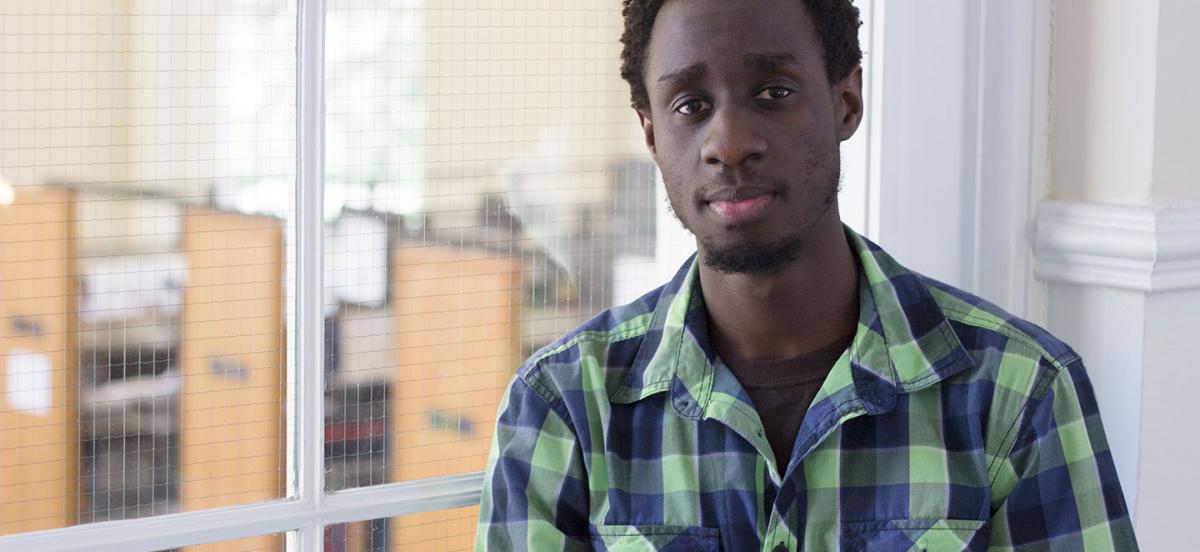Summer Centered: Trevor Esilu ’21 Helps Man’s Best Friend Stay Healthy

Aspiring veterinarian Trevor Esilu '21 was photographed on campus by Hannah Weissmann '17.
Details
The aspiring wildlife veterinarian is conducting research on the canine version of the Insulin-Like Growth Factor 1 hormone at Penn Vet.
In the fluorescent-lit laboratories of the University of Pennsylvania’s School of Veterinary Medicine’s research department, Trevor Esilu ’21 focuses his attention on patients of a predominantly canine persuasion. From small chihuahuas to bearlike Newfoundlands, he’s seen every size, shape, and color the species has to offer. For Esilu, who aims to become a wildlife veterinarian in his native Botswana, however, dogs are a small first step to the cheetahs, hyenas, and Cape buffalo he hopes to treat in the future.
“This internship has opened my eyes to the types of questions and approaches that vets take to understand a phenomenon or problem, and study it,” Esilu says. “Essentially, it has been a golden opportunity to combine my interests in vet medicine and research.”
That opportunity came about through the efforts of current Haverford pre-vet advisor Jenni Punt. A professor of immunology and biology at PennVet (and the dean of OneHealth, a medical initiative that posits that the well-being of all living things is interconnected), she recruited Esilu to conduct research for a project she’s been working on for the past year now.
“One of the biggest motivators for me to do this internship was Jenni,” says Esilu, who characterizes her as “by far the best mentor I’ve ever had in my life.” “She asked me to join her research without requesting my resume, knowing my grades, gauging my dexterity in the lab, or even asking me to apply. Rather, she saw how passionate I was about animals and science and decided to take a chance on me. As a young and inexperienced researcher, it is so encouraging to find a mentor who cares more about what you can achieve rather than what you have achieved.”
The nature of this research project is a weighty one for a first-time researcher---but Esilu has risen to the occasion admirably.
“In particular,” he says, “my work focuses on a particular hormone called Insulin-Like Growth Factor 1 (IGF1) and how it affects the canine immune system. In dogs and humans, IGF1 is thought to be responsible for both growth and longevity and, especially for dogs, it is believed to cause the distinguishable size difference between breeds; it is one of the likely reasons why we have the amazing size differences between the micro-Chihuahua, the macro-Great Dane, and everything in between.”
For dog lovers, the inverse correlation between size and longevity has long been taken as a tragic given. But Punt’s research initiative, though not the first to do so, is taking steps to provide some hard scientific evidence for this widespread belief—and has discovered that the genetic reality is far more complex than anyone could've guessed.
“We believe that the more IGF1 a dog express, the larger the dog. However, it’s well-known that the larger the dog is, the more susceptible it is to developing cancer,” Esilu says. “Consequently, larger dogs have shorter lifespans than smaller ones. The aim of our project is to see if increased concentrations of IGF1 in canine blood serum suppresses the immune system by influencing thefunctions of regulatory T cells—white blood cells that help protect against autoimmune disease.”
Over the course of his internship, which is funded by the Marian E. Koshland Integrated Natural Sciences Center’s Summer Scholars program, Esilu has learned a lot: how to use a flow cytometer, an “incredibly innovative tool that takes advantage of the specificity of antibodies to particular chemical receptors on the cells,” and its corresponding analysis program FlowJo; how to grow cells in a culture; how to most effectively determine the chemical makeup of a vial of blood. Increasingly, however, he sees these veterinary medical techniques as as-yet-untapped gold mines when it comes to preserving endangered species, a cause clearly close to his own heart.
"Early on," he says, "Jenni made it clear to me that there’s so much information that one can get from just 100 microliters of blood–one-tenth of a milliliter, or 0.3 percent of an ounce. It got me thinking about breeding programs because endangered animals are incredibly valuable since the fate of their species literally depends on their well-being. When performing diagnostics on them, it is best to be as non-invasive as possible. So, I started thinking that an interesting way of determining many complex details about an animal’s health with the least amount of invasion might be through the question ‘How much more diagnostic information can we find out about an animal's health with just 100 μL of its blood?'"
Even if this seemingly promising idea doesn’t pan out, though, Esilu’s summer internship has taught him that failure is sometimes just success in disguise.
“Research is like advanced troubleshooting,” he says. “Making big mistakes tells you a lot. You definitely learn that you’re doing something wrong and maybe if you’re lucky, you could discover something that you weren’t even looking for.”
“Summer Centered” is a series exploring Haverford students’ Center-funded summer work.



